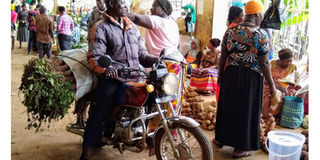Sweet potato – A Crop for Everyone

One of the qualities of the sweet potato is that it is a growing source of economic livelihood for many, and especially women. Photo by J.Okonya/CIP
We all know that the delicious sweet potato is a staple food in Uganda. Along with cassava, it is one of the most popular root crops in the country.
Part of its popularity lies in the fact that there are so many ways to prepare this delicious and versatile food for eating: steamed, boiled, roasted, fried, mashed, made into flour, crisps or used in dishes mixed with other food, such as the sweet potato-bean mash known as “mugoyo.”
Then there are the numerous beautiful local varieties of sweet potato: New Kawogo, Dimbuka, Sukali, Tanzania, Kawogo, Bwanjule, Sowola, Wagabolige and more. In the marketplace, these varieties are distinguished less by name than the physical characteristics, such as purple skin or yellow flesh.
Importantly for Ugandans, sweet potato is also very high in nutrients. Take orange-fleshed sweet potato (OFSP), for example. It contains high levels of beta carotene (necessary for vitamin A delivery) and many other essential nutrients that can ward off nutrition-related diseases and ensure improved physical development in children.
On top of all these qualities, sweet potato is a growing source of economic livelihood for many, and especially women.
Since 1988, the International Potato Center (CIP) has worked in Uganda to promote and ensure the growth and improvement of sweet potato varieties (along with the “irish” potato). CIP also provides vital support to nutrition education, value chain development, improved agronomic practices, and dissemination of crop varieties. Taken together, they ensure that our potato and sweet potato systems are robust and productive, providing more food and income for Ugandans.
Partnerships are key to CIP’s work. Subsequently CIP has built an extensive network in collaboration with National Agricultural Research Organization (NARO), Harvest Plus, Makerere University, World Vision, VEDCO, CHAIN-Uganda, Uganda Martyrs University, SENNAI and BioCrops, among others.
CIP also sought to understand women’s preferences for sweet potato so that we can develop varieties that will meet their needs in the field, kitchen and marketplace. In doing so, we can ensure that more Ugandans eat and have access to healthy crops.
A focus on women is crucial because they make decisions regarding the family’s food choices and they are the main cultivators of sweet potato as a crop. Indeed, in many areas of the country, sweet potato is regarded as a “woman’s crop” while men say it is not “manly” for them to be involved with sweet potato farming. Women are discouraged by this lack of support.
These different attitudes convert into important differences in access between men and women for agricultural support. For example, we have discovered that Ugandans could grow more sweet potato, but women are limited by resource constraints, low education, and low access to financial services and agricultural tools that could bolster production.
So, the solution is clear: if Uganda would like to improve family nutrition while developing a profitable new market, having men and women embrace this crop will be crucial. A family investment in sweet potato will provide excellent returns on investment – in health and income.
To help address this challenge, CIP is collaborating with partners to develop new sweet potato varieties that not only grow well in challenging climates but also perform well in the kitchen with taste and easy cookability.
Indeed, the humble sweet potato is not a crop for men or women. It is a crop that serves entire families, delivering nutrition, good taste, and better incomes for all Ugandans.
To learn more about CIP visit us at www.cipotato.org
This story is sponsored by International Potato Center


